Meidum ‘Collapsed’ Pyramid Of Great Builder Pharaoh Snefru
A. Sutherland - AncientPages.com - Pharaoh Snefru (Sneferu) was the founder of the 4th dynasty during the Old Kingdom.
Snefru is considered the greatest builder in Egyptian history, who reigned from around 2613 BC to 2589 BC, according to Manetho, an Egyptian priest, living in the third century BC.
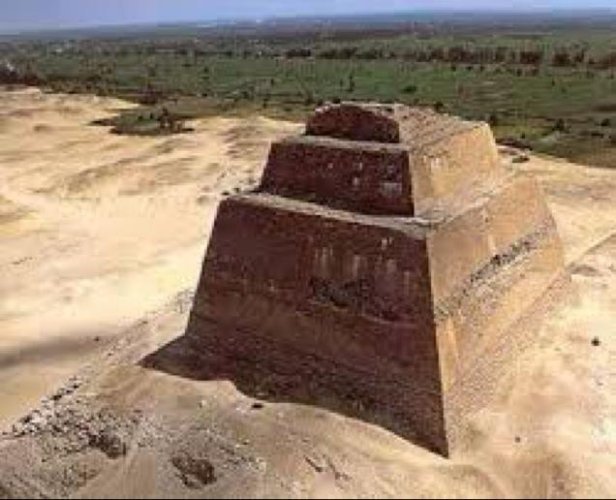
Some suggest the pyramid not to have collapsed until the New Kingdom, but there are a number of facts contradicting this theory. The Meidum Pyramid seems never to have been completed.
He built at least three pyramids that survive to this day and is also contributed with several innovations regarding design and construction of pyramids in ancient Egypt.
Snefru was born and grew up in the royal palace in Memphis, not far from modern city of Cairo. His father was King Huni, who was the last pharaoh of the Third Dynasty and his mother was a royal princess, Meresankh. It is believed she was Huni's sister.
Pharaohs were often wed to their sisters and it was nothing unusual in this ancient Egyptian tradition.
Snefru was the father of Khufu (2589-2566 BC), the 4th Dynasty Pharaoh who ruled during the first half of the Old Kingdom period. Khufu is widely accepted as the ruler who commissioned the Great
Pyramid of Giza, one of the Seven Wonders of the World.
These pyramids are the Red Pyramid, the Bent Pyramid, and the third one, Meidum Pyramid (also known as the ‘Collapsed' Pyramid. Inside the Bent Pyramid, an inscription with Snefru's name and a stela discovered by archaeologists alongside the neighboring, subsidiary pyramid shows Snofru himself.)
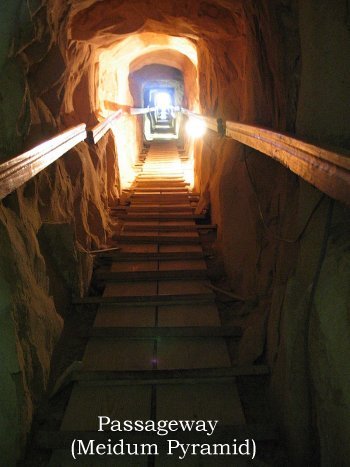 Despite the fact that a last ruler of the Dynasty III, pharaoh Huni and father of Snefru, erected the Meidum Pyramid, the structure was definitely completed by Snefru, most probably after his father’s death.
Despite the fact that a last ruler of the Dynasty III, pharaoh Huni and father of Snefru, erected the Meidum Pyramid, the structure was definitely completed by Snefru, most probably after his father’s death.
A Middle Kingdom papyrus recorded:
"The Majesty of King Huni died, and the Majesty of King Snofru was raised up as a benevolent King in this entire land."
The Meidum Pyramid can be found approximately 62 miles (100 km) south of modern Cairo 30 miles (48 km) south of Memphis.
It was 93m high and built with a 114m long square base. Its entrance, built about 30m above ground level, in the pyramid’s northern face, leads to a corridor descending for 54 meters. In its final form the structure stood about 311ft (95m) high.
The structure seems to have been planned to be a stepped pyramid, and its central square had to form both the nucleus and peak of the pyramid. Around it the builders added a succession of six layers around it, of which each was sloping at an angle of 75 degrees towards the structure's core. All layers were covered with white limestone, however, the last layer, therefore, rested not on solid rock but rather on three layers of limestone blocks and sand.
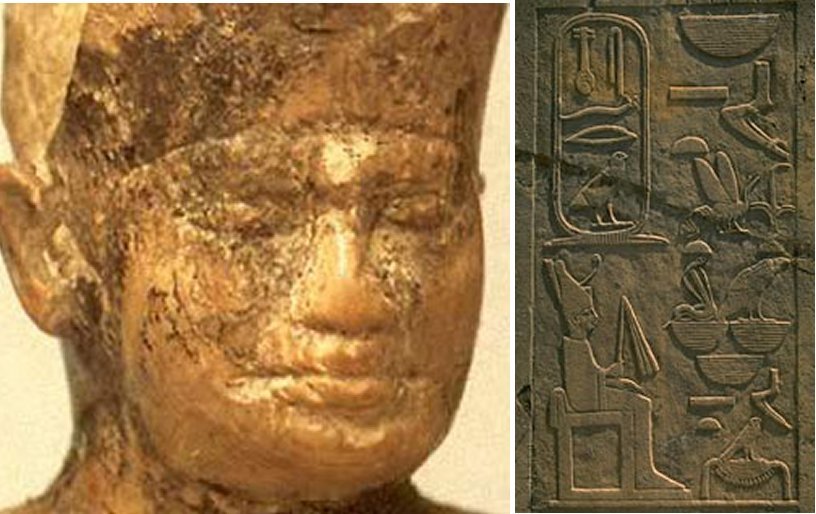
Left: Snefru, 1st King of Egypt's 4th Dynasty; Right: Stela depicting 4th Dynasty King Snofru. IMage via bbc.co.uk
The pyramid became unstable. Its heavy outer layers were completely ruined in antiquity. It is not exactly known when in antiquity this collapse happened. It is believed that the structure at least partially collapsed by the time of the New Kingdom, around 1550 BC.
See also:
Sobek - Enigmatic Crocodile God of Ancient Egypt
Ancient Egyptian Capital Tell El-Amarna Mapped Through Satellite Imagery System
Interesting Ancient Civilizations
What is important is, this pyramid-like structure seems never to have been completed.
For example, the mortuary temple, located under the rubble at the base of the pyramid, in fact, never was finished. Archaeologists have discovered that the temple’s two steles without inscriptions and the burial chamber inside the pyramid itself, has never been completed. Also wooden supports – usually removed after construction - have been found still in place.
Today, the Meidum 'Collapsed' Pyramid hardly resembles a pyramid.
Written by – A. Sutherland - AncientPages.com Senior Staff Writer
Copyright © AncientPages.com All rights reserved. This material may not be published, broadcast, rewritten or redistributed in whole or part without the express written permission of AncientPages.com
Expand for referencesMore From Ancient Pages
-
 Riddle Of An Ancient Underground City No-One Thinks Exist – Have We Misunderstood Plato? Part 1
Ancient Mysteries | Sep 16, 2019
Riddle Of An Ancient Underground City No-One Thinks Exist – Have We Misunderstood Plato? Part 1
Ancient Mysteries | Sep 16, 2019 -
 Surprisingly Complex History Of Crocodiles – New Study
Evolution | Nov 23, 2023
Surprisingly Complex History Of Crocodiles – New Study
Evolution | Nov 23, 2023 -
 Never-Before-Seen Roman-Era Wall Paintings Discovered In Ashkelon Revealed To The Public For The First Time
Archaeology | Aug 30, 2024
Never-Before-Seen Roman-Era Wall Paintings Discovered In Ashkelon Revealed To The Public For The First Time
Archaeology | Aug 30, 2024 -
 Trolls – Fascinating Mythical Creatures Of Scandinavia
Featured Stories | Jun 13, 2022
Trolls – Fascinating Mythical Creatures Of Scandinavia
Featured Stories | Jun 13, 2022 -
 Ancient ‘Yahweh And His Asherah’ Inscriptions At Kuntillet ‘Ajrud Remain An Unsolved Biblical Mystery
Biblical Mysteries | Feb 12, 2021
Ancient ‘Yahweh And His Asherah’ Inscriptions At Kuntillet ‘Ajrud Remain An Unsolved Biblical Mystery
Biblical Mysteries | Feb 12, 2021 -
 New Study Challenges The Beginning Of Civilization
Archaeology | Apr 11, 2022
New Study Challenges The Beginning Of Civilization
Archaeology | Apr 11, 2022 -
 Alexander The Great’s Mysterious And Unexplained Encounter In Babylon
Ancient Mysteries | Jul 15, 2021
Alexander The Great’s Mysterious And Unexplained Encounter In Babylon
Ancient Mysteries | Jul 15, 2021 -
 Rare 500-Year-Old Wreck From Missing Ship Samson Discovered In Central Stockholm, Sweden
Archaeology | Dec 20, 2019
Rare 500-Year-Old Wreck From Missing Ship Samson Discovered In Central Stockholm, Sweden
Archaeology | Dec 20, 2019 -
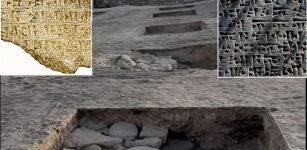 Monumental Structure Unearthed During Excavations Of Urartu-Era Karmir Blur
Archaeology | Nov 25, 2022
Monumental Structure Unearthed During Excavations Of Urartu-Era Karmir Blur
Archaeology | Nov 25, 2022 -
 Native American Sun Dance: Important Ceremony Of The Plains Indians Of North America
Ancient History Facts | May 20, 2016
Native American Sun Dance: Important Ceremony Of The Plains Indians Of North America
Ancient History Facts | May 20, 2016 -
 Mabon Festival And The Autumn Equinox Celebrated By Pagans
Ancient Traditions And Customs | Sep 19, 2024
Mabon Festival And The Autumn Equinox Celebrated By Pagans
Ancient Traditions And Customs | Sep 19, 2024 -
 People With Neanderthals’ Pain-Related Gene May Suffer More On A Daily Basis
DNA | Jul 27, 2020
People With Neanderthals’ Pain-Related Gene May Suffer More On A Daily Basis
DNA | Jul 27, 2020 -
 Pharaoh Ay – A Man With A Hidden Agenda Or A Victim Of Unfortunate Circumstances?
Featured Stories | Feb 5, 2019
Pharaoh Ay – A Man With A Hidden Agenda Or A Victim Of Unfortunate Circumstances?
Featured Stories | Feb 5, 2019 -
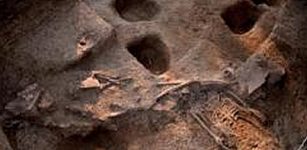 Iron Age Site Of Khok Phutsa Excavated In Thailand
Archaeology | Apr 15, 2019
Iron Age Site Of Khok Phutsa Excavated In Thailand
Archaeology | Apr 15, 2019 -
 Connection Between Viruses And Ancestors Of All Complex Life Has Been Found
Archaeology | Jul 1, 2022
Connection Between Viruses And Ancestors Of All Complex Life Has Been Found
Archaeology | Jul 1, 2022 -
 Unique Pig-Shaped Figurine Found In East China Was Probably A Child’s Toy 6,000-Years Ago
Archaeology | Jun 9, 2023
Unique Pig-Shaped Figurine Found In East China Was Probably A Child’s Toy 6,000-Years Ago
Archaeology | Jun 9, 2023 -
 Rare Ancient Drawings Offer Evidence Moluccan Boats Visited Australia From Indonesia?
Archaeology | May 31, 2023
Rare Ancient Drawings Offer Evidence Moluccan Boats Visited Australia From Indonesia?
Archaeology | May 31, 2023 -
 Thousand-Year-Old Farming Techniques And Irrigation Systems Can Be Used To Mitigate Climate Change
Archaeology | Mar 7, 2018
Thousand-Year-Old Farming Techniques And Irrigation Systems Can Be Used To Mitigate Climate Change
Archaeology | Mar 7, 2018 -
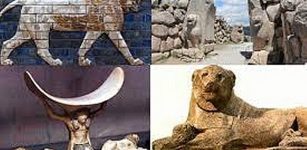 The Majestic Lion: Ancient Symbol Of Power And Royalty Found World-Wide
Ancient Symbols | Oct 10, 2017
The Majestic Lion: Ancient Symbol Of Power And Royalty Found World-Wide
Ancient Symbols | Oct 10, 2017 -
 Secret Behind Ancient Durable Maya Plaster Discovered
Archaeology | Apr 21, 2023
Secret Behind Ancient Durable Maya Plaster Discovered
Archaeology | Apr 21, 2023
